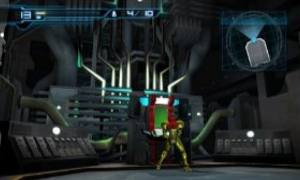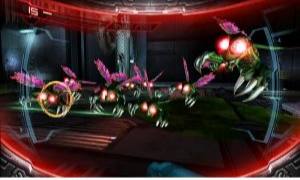| |
 Metroid
Other M (Wii) Metroid
Other M (Wii)
You probably thought you knew what to expect from a Metroid title.
Nintendo had other ideas, unexpectedly enlisting Team Ninja to produce and
design the newest installment, Other M for the Wii. This version changes a
few things. Eschewing for the most part, the Prime titles' exclusive first
person perspective for a mix of third and first is an interesting idea,
and the extended cut-scenes add some depth to the backstory. In addition,
new abilities such as close range attacks give Other M a different feel
from a gameplay standpoint. The question is, do these changes work or does
the reboot fall short? Look inside and discover the answer. |
Nintendo made a lot of waves when they
announced that Tecmo's Team Ninja would be taking over the reins of its
long running series. After a long wait, the finished product of this
partnership has been released and while there have been many changes made,
there are also many familiar elements. After all, players have a certain
set of expectations when they plug in a new Metroid game, and this one
stays within the usual parameters. Once again, the game stars Samus Aran,
and as usual she has her usual abilities. She can fire standard shots or
missiles at opponents, there are several types of these that she can use.
As you progress through the game, you'll also find other abilities that
she can use. As expected, her Morph ball form which allows her to roll
through levels make a return but the game also has a few twists as well.
Unlike the last couple of games, Other M offers a mix of third and first
person action. Most of the game is played in third person mode, where you
use the d-pad to move samus and use the action buttons as you would have
in the classic NES and SNES installments. You can switch the camera to
first person perspective when you need to lock onto or target specific
enemies. This is done by holding the wiimote vertically pointing at the
screen. Unfortunately, you have to do this each time you want to switch
views, which can become annoying. While the new perspective functionality
seems to be an odd choice at first, there are a few new elements that this
leads to, which helps to open up the game mechanics to innovative new
features.
One of the most interesting new
abilities that Samus has in her arsenal are the new close range attacks.
The two main types of these are called Lethal Strikes and Overcharge
moves. Using a lethal strike move is simple. By pressing the charge button
while an enemy is down, you can unleash a powerful attack that will
pulverize or destroy them instantly. Samus can also use the new Overcharge
moves, which work similarly and occur when you jump on an enemy. Getting
on top of them is trickier than it sounds and takes some practice. These
close-combat attacks work together to give the action in Other M a much
more visceral, you might even say violent feel. They're definitely cool to
look at, and most importantly can be quite effective. Taken together, they
work in tandem to help you down enemies that otherwise would be almost
impossible to destroy. These are slightly odd feeling at first, but with a
little bit of practice, most players should be able to get the hang of
them quickly. Team Ninja has done an excellent job in seeing that these
new techniques are integrated into Other M's more traditional play
mechanics. However, they seem like distractions or gimmicks that don't
really add much to the basic gameplay in Metroid. There are some combat
sequences which feel overly frustrating in many ways, but the game offers
frequent save points throughout, so your progress never feels completely
blocked. Fortunately, the most engaging parts of the series, which come in
unlocking puzzles, scanning enemies for clues and discovering the weak
points in opponents are still very much present, though they've been
de-emphasized. In taking this approach, Team Ninja has made Other M feel
much less like a Metroid title and moved the balance more towards that of
a traditional shooter. There are still plenty of puzzles to solve,
elevators to climb and jumping or rolling sections in the game, but it
seems more predictable than in previous games. The levels themselves
unfold at a somewhat decent pace, though the game itself feels choppier
and less coherent overall.
 Unlike
previous adventures, where our heroine was mostly silent and let her guns
do the talking, she is now a full-fledged character this time around.
During the course of the game, layers will uncover many elements and
characters from her backstory. These events unfold with a series of
cutscenes, some of which are pretty extensive, that occur during the game.
Samus' story is a bit long and convoluted, but the game's plot is fairly
simple in terms of pacing and characters. Metroid: Other M, takes place as
galactic bounty hunter Samus Aran finds herself crossing paths with a
mysterious force that she's seen before in previous adventures. Finding
the key to this force is also how she will find out how she acquired the
many special abilities she has. On her way to confronting her demons, she
also encounters the members of a special operations force she was
previously a member of. The game takes her to a deserted military base
that's been over-run with these mysterious creatures, known as Metroids.
As she encounters them, she can also catalog and examine them, which can
lead her to further clues. Its fairly elaborate, but the acting and
presentation leaves a lot to be desired, which means this portion of the
game isn't as effective as it could be. Too often, it seems like the
storyline and plot get in the way of the action, stopping the gameplay
just as momentum seems to be building. Since so much suspense and drama
has been poured into these sections, it makes the rest of the game seem
almost tacked on, even some of the boss battles seem anticlimactic, as if
they are mere props to move along the story. This makes Other M feel less
coherent than it should. At points, this can be really annoying and makes
you feel like you're watching an anime movie, rather than playing a game
that you're interacting with. Unlike
previous adventures, where our heroine was mostly silent and let her guns
do the talking, she is now a full-fledged character this time around.
During the course of the game, layers will uncover many elements and
characters from her backstory. These events unfold with a series of
cutscenes, some of which are pretty extensive, that occur during the game.
Samus' story is a bit long and convoluted, but the game's plot is fairly
simple in terms of pacing and characters. Metroid: Other M, takes place as
galactic bounty hunter Samus Aran finds herself crossing paths with a
mysterious force that she's seen before in previous adventures. Finding
the key to this force is also how she will find out how she acquired the
many special abilities she has. On her way to confronting her demons, she
also encounters the members of a special operations force she was
previously a member of. The game takes her to a deserted military base
that's been over-run with these mysterious creatures, known as Metroids.
As she encounters them, she can also catalog and examine them, which can
lead her to further clues. Its fairly elaborate, but the acting and
presentation leaves a lot to be desired, which means this portion of the
game isn't as effective as it could be. Too often, it seems like the
storyline and plot get in the way of the action, stopping the gameplay
just as momentum seems to be building. Since so much suspense and drama
has been poured into these sections, it makes the rest of the game seem
almost tacked on, even some of the boss battles seem anticlimactic, as if
they are mere props to move along the story. This makes Other M feel less
coherent than it should. At points, this can be really annoying and makes
you feel like you're watching an anime movie, rather than playing a game
that you're interacting with.
Metroid: Other M deserves credit for
attempting to place the series on a new path. Unfortunately, many of the
changes and re-imagining done by Team Ninja don't work. While the new
finishing moves and close range attacks are quite effective, some of the
other elements just don't work. On paper, there are some good ideas but
the sub-par execution means the final product leaves a lot to be desired.
Its extended cut scenes are forgettable, poorly acted and detract from the
main gameplay. Most of the action has been seen in other Metroid games,
and the motion control mechanic of switching between first and third
person perspectives can be distracting. This is particularly true during
the heat of battle when its not always obvious which angle will be most
effect. Aiming the wiimote at the screen to shoot enemies at close is a
fine idea in theory, but the limited view it provides means you'll take a
lot of damage unnecessarily. This makes for a hugely frustrating
experience at points where you lose energy for no reason other than the
poor design. Other M's level designs are merely average and fail to live
up to the best seen in the Prime series, leaving you with a distinct
impression that you've seen this before and done better. The puzzles are
almost uniformly predictable and while the new close-in fighting
techniques add some drama to boss battles, they become predictable and
monotonus very quickly. Its short length and somewhat simplified level of
difficulty is sure to disappoint players who expect more from the series.
Other M's storyline is also a little bit below average for the series,
giving you less incentive to keep playing. In closing, Metroid Other M is
a good example of what happens when good ideas meet poor design. Despite
its flaws, Other M isn't a terrible game, merely an average one. Judging
by the standards set by the earlier Metroid games, this makes Other M a
disappointing experience.
-
Michael Palisano
|
| |
|

